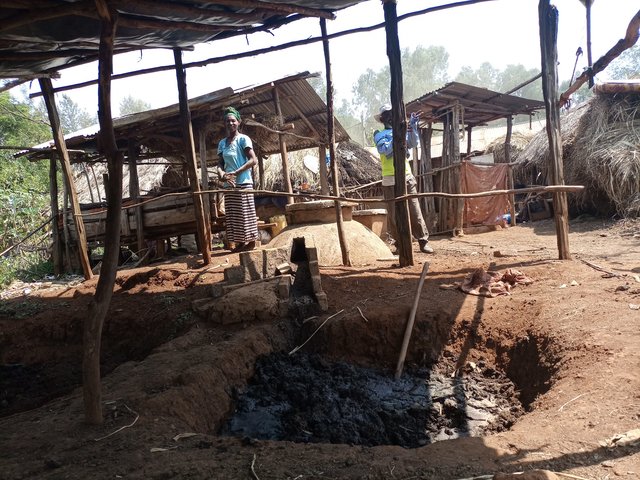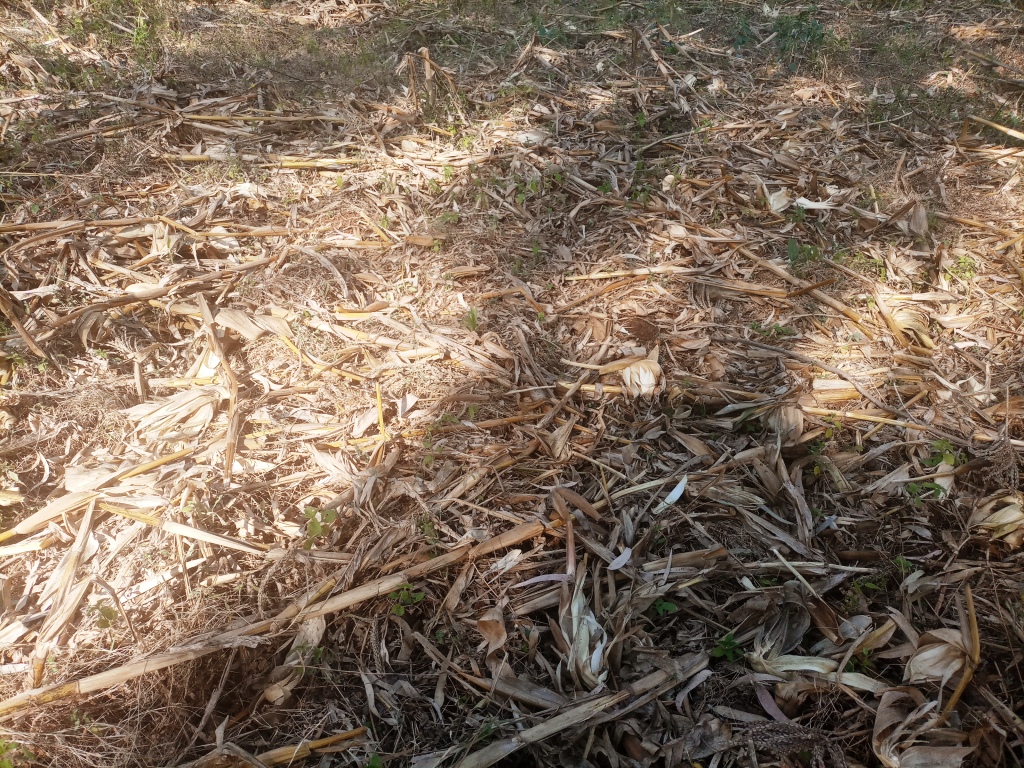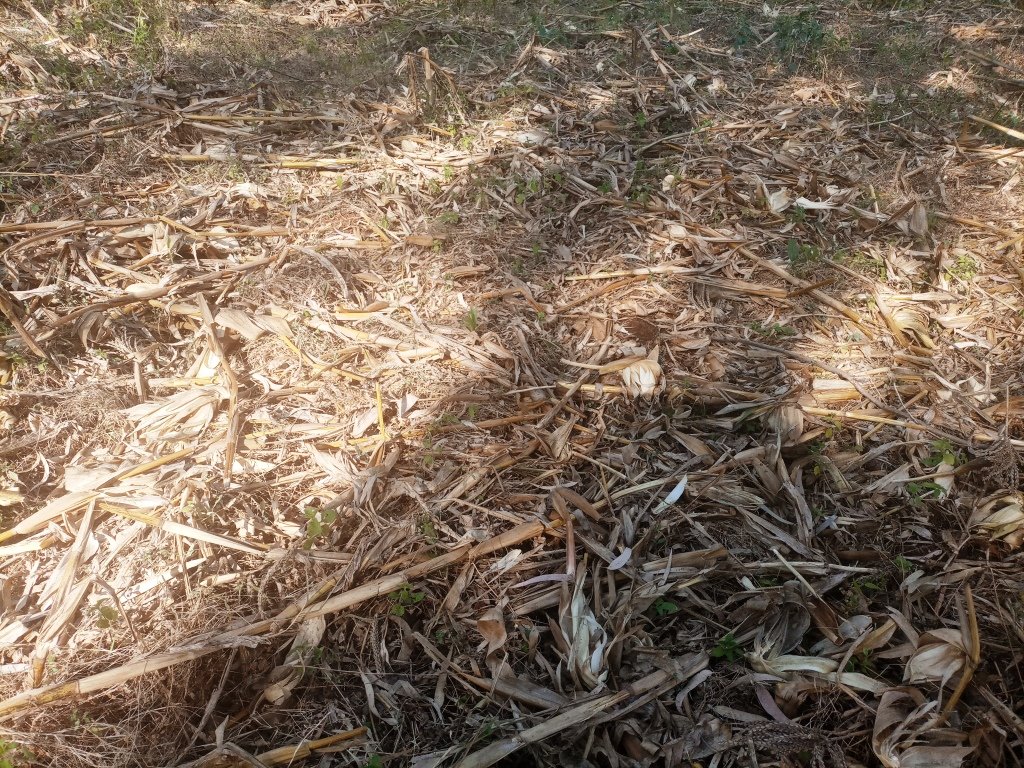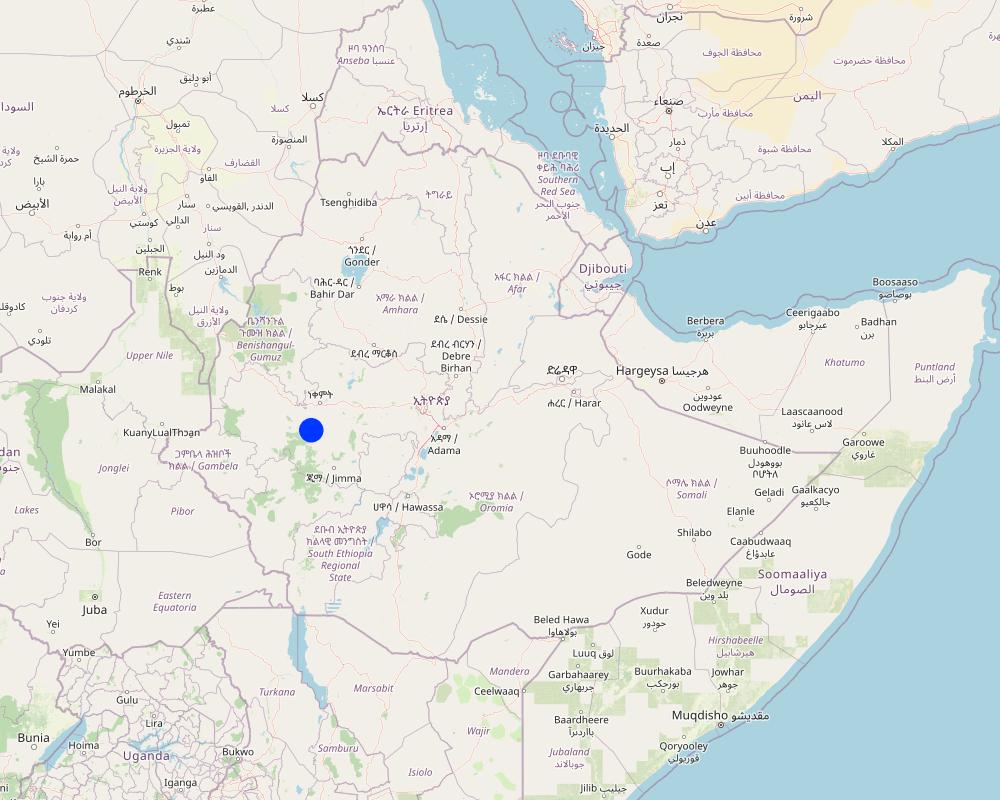Crop Residue Management [Ethiopia]
- Creation:
- Update:
- Compiler: GERBA LETA
- Editors: Noel Templer, Julia Doldt, Kidist Yilma, Tabitha Nekesa, Ahmadou Gaye, Siagbé Golli
- Reviewers: William Critchley, Rima Mekdaschi Studer, Sally Bunning
Hafte Midhani
technologies_6644 - Ethiopia
View sections
Expand all Collapse all1. General information
1.2 Contact details of resource persons and institutions involved in the assessment and documentation of the Technology
Key resource person(s)
land user:
Woyessa Habtamu
Farmer
Ethiopia
Name of project which facilitated the documentation/ evaluation of the Technology (if relevant)
Soil protection and rehabilitation for food security (ProSo(i)l)Name of the institution(s) which facilitated the documentation/ evaluation of the Technology (if relevant)
Alliance Bioversity and International Center for Tropical Agriculture (Alliance Bioversity-CIAT) - Kenya1.3 Conditions regarding the use of data documented through WOCAT
The compiler and key resource person(s) accept the conditions regarding the use of data documented through WOCAT:
Yes
1.4 Declaration on sustainability of the described Technology
Is the Technology described here problematic with regard to land degradation, so that it cannot be declared a sustainable land management technology?
No
1.5 Reference to Questionnaire(s) on SLM Approaches (documented using WOCAT)

Integrated Soil Fertility Management (ISFM) [Ethiopia]
The Integrated Soil Fertility Management (ISFM) approach has been adopted under the Integrated Soil Fertility Management Project (ISFM+). It was introduced as a quick-win solution to increase both crop and biomass production through the incremental promotion of varied but complementary technology packages.
- Compiler: GERBA LETA
2. Description of the SLM Technology
2.1 Short description of the Technology
Definition of the Technology:
Crop residue management involves leaving stover and other trash from cereal crops (including tef, wheat and maize), as well as haulms of legumes, in the field. Crop residues keep the soil covered, retain organic matter and moisture in the soil, and help to ensure better production.
2.2 Detailed description of the Technology
Description:
Crop residue management involves leaving stover and other trash from cereal crops (including tef, wheat and maize), as well as haulms of legumes, in the field. Crop residue (CR) management is integral to soil health: it yields multiple benefits such as mitigating the risks of soil loss to water erosion, reducing the decomposition of organic matter and storing extra carbon. It also increases the fertility status of degraded soils and helps to improve soil structure and moisture properties. Degraded soils are at risk of tillage, water, and wind erosion. Soils degrade quickly when not covered and when no effort is made to increase organic matter levels or improve soil structure. Crop residue management plays an important role in arresting soil degradation and improving soil properties, and eventually increasing crop production. Therefore, it has positive economic and ecological functions. The aim of applying this technology is to improve soil fertility, reduce soil acidity and demands for synthetic fertilizers. Overall, crop residue management allows land users to sustainably use their land over a long period without losing its productive potential. In this part of Ethiopia, land users used to leave maize and millet stover in the fields but this is challenged by the prevalence of free (open access) grazing. Thus, controlling grazing is one prerequisite to ensuring adoption of the technology. Monocropping also reduces biomass production. Land users appreciate the extra grain yields from crop residue-rich farms. CR management also retains moisture and enables early tillage operations. In summary, the application of appropriate CR management provides multiple benefits. It mitigates the risks of erosion, reduces excessive mining of CR, reduces the rate of decomposition of organic matter, increases the fertility status of degraded soils, and increases crop production and sustainable productivity.
2.3 Photos of the Technology
General remarks regarding photos:
The photo portrays one of the many crop residue management practices applied on different crops.
2.4 Videos of the Technology
Comments, short description:
Videos of this technology is not documented.
2.5 Country/ region/ locations where the Technology has been applied and which are covered by this assessment
Country:
Ethiopia
Region/ State/ Province:
Oromia
Specify the spread of the Technology:
- evenly spread over an area
If precise area is not known, indicate approximate area covered:
- 0.1-1 km2
Is/are the technology site(s) located in a permanently protected area?
No
Map
×2.6 Date of implementation
Indicate year of implementation:
2015
If precise year is not known, indicate approximate date:
- less than 10 years ago (recently)
2.7 Introduction of the Technology
Specify how the Technology was introduced:
- as part of a traditional system (> 50 years)
- through projects/ external interventions
Comments (type of project, etc.):
Integrated Soil Fertility Management Project (ISFM+) of the GIZ.
3. Classification of the SLM Technology
3.1 Main purpose(s) of the Technology
- improve production
- reduce, prevent, restore land degradation
- conserve ecosystem
- preserve/ improve biodiversity
- create beneficial economic impact
3.2 Current land use type(s) where the Technology is applied
Land use mixed within the same land unit:
No

Cropland
- Annual cropping
Annual cropping - Specify crops:
- cereals - wheat (spring)
- cereals - maize
- cereals - millet
- cereals - Tef
Number of growing seasons per year:
- 1
Is intercropping practiced?
No
Is crop rotation practiced?
Yes
3.3 Has land use changed due to the implementation of the Technology?
Has land use changed due to the implementation of the Technology?
- No (Continue with question 3.4)
3.4 Water supply
Water supply for the land on which the Technology is applied:
- rainfed
3.5 SLM group to which the Technology belongs
- integrated crop-livestock management
- improved ground/ vegetation cover
- integrated soil fertility management
3.6 SLM measures comprising the Technology

agronomic measures
- A2: Organic matter/ soil fertility
- A3: Soil surface treatment
- A6: Residue management
- A7: Others
A3: Differentiate tillage systems:
A 3.3: Full tillage (< 30% soil cover)
A6: Specify residue management:
A 6.4: retained

management measures
- M2: Change of management/ intensity level
Comments:
With tillage, the crop residue is incorporated well into the soil system. It improves soil structure by contributing organic matter with the benefits of facilitating infiltration and reducing surface runoff.
3.7 Main types of land degradation addressed by the Technology

soil erosion by water
- Wt: loss of topsoil/ surface erosion

chemical soil deterioration
- Cn: fertility decline and reduced organic matter content (not caused by erosion)
- Ca: acidification

physical soil deterioration
- Pc: compaction
- Ps: subsidence of organic soils, settling of soil

biological degradation
- Bc: reduction of vegetation cover
- Bq: quantity/ biomass decline
- Bs: quality and species composition/ diversity decline
- Bl: loss of soil life
3.8 Prevention, reduction, or restoration of land degradation
Specify the goal of the Technology with regard to land degradation:
- reduce land degradation
- restore/ rehabilitate severely degraded land
Comments:
It ensures the sustainable productivity potential of the soil.
4. Technical specifications, implementation activities, inputs, and costs
4.2 General information regarding the calculation of inputs and costs
Specify how costs and inputs were calculated:
- per Technology area
Indicate size and area unit:
4 sanga
If using a local area unit, indicate conversion factor to one hectare (e.g. 1 ha = 2.47 acres): 1 ha =:
1ha
other/ national currency (specify):
ETB
If relevant, indicate exchange rate from USD to local currency (e.g. 1 USD = 79.9 Brazilian Real): 1 USD =:
53.12
4.3 Establishment activities
| Activity | Timing (season) | |
|---|---|---|
| 1. | Mowing the crop by leaving some proportion on the ground. | Harvesting |
| 2. | Keep of livestock grazing | Dry season |
| 3. | Plow over the crop residue early on. | Late in the dry season. |
4.4 Costs and inputs needed for establishment
Comments:
The technology needs changing the mindset of the land users than the money/finance for the establishment and maintenance of it. Uniform distribution of rainfall is essential to plan the plowing time to incorporate the residue well into the soil.
4.5 Maintenance/ recurrent activities
| Activity | Timing/ frequency | |
|---|---|---|
| 1. | Keep the farm with crop residue intact from livestock | During off-season. |
Comments:
Prohibiting the use of a proportion of crop residue for fuel, construction, and livestock feed is enough to put in place the technology.
4.6 Costs and inputs needed for maintenance/ recurrent activities (per year)
If you are unable to break down the costs in the table above, give an estimation of the total costs of maintaining the Technology:
2500.0
Comments:
Allocated some money just to keep off the interference of livestock to the farmland during the off-season. The cost can be covered by land users themselves but need awareness creation on SLM using crop residue as one of the best practices.
4.7 Most important factors affecting the costs
Describe the most determinate factors affecting the costs:
Change of the cost is related to the inflation and economic instability.
5. Natural and human environment
5.1 Climate
Annual rainfall
- < 250 mm
- 251-500 mm
- 501-750 mm
- 751-1,000 mm
- 1,001-1,500 mm
- 1,501-2,000 mm
- 2,001-3,000 mm
- 3,001-4,000 mm
- > 4,000 mm
Specify average annual rainfall (if known), in mm:
1947.00
Specifications/ comments on rainfall:
The area received summer maximum rainfall.
Indicate the name of the reference meteorological station considered:
Bedele
Agro-climatic zone
- sub-humid
The uniform distribution of rainfall is helpful to incorporate the residue in time.
5.2 Topography
Slopes on average:
- flat (0-2%)
- gentle (3-5%)
- moderate (6-10%)
- rolling (11-15%)
- hilly (16-30%)
- steep (31-60%)
- very steep (>60%)
Landforms:
- plateau/plains
- ridges
- mountain slopes
- hill slopes
- footslopes
- valley floors
Altitudinal zone:
- 0-100 m a.s.l.
- 101-500 m a.s.l.
- 501-1,000 m a.s.l.
- 1,001-1,500 m a.s.l.
- 1,501-2,000 m a.s.l.
- 2,001-2,500 m a.s.l.
- 2,501-3,000 m a.s.l.
- 3,001-4,000 m a.s.l.
- > 4,000 m a.s.l.
Comments and further specifications on topography:
Since the farming at stallholder level is manual using traction power, the introduction of this technology is not obstructed by the topography as long as the land is under farming.
5.3 Soils
Soil depth on average:
- very shallow (0-20 cm)
- shallow (21-50 cm)
- moderately deep (51-80 cm)
- deep (81-120 cm)
- very deep (> 120 cm)
Soil texture (topsoil):
- medium (loamy, silty)
Soil texture (> 20 cm below surface):
- medium (loamy, silty)
Topsoil organic matter:
- medium (1-3%)
5.4 Water availability and quality
Ground water table:
5-50 m
Availability of surface water:
good
Water quality (untreated):
good drinking water
Water quality refers to:
surface water
Is water salinity a problem?
No
Is flooding of the area occurring?
No
5.5 Biodiversity
Species diversity:
- medium
Habitat diversity:
- medium
5.6 Characteristics of land users applying the Technology
Sedentary or nomadic:
- Sedentary
Market orientation of production system:
- mixed (subsistence/ commercial)
Off-farm income:
- less than 10% of all income
Relative level of wealth:
- average
Individuals or groups:
- individual/ household
Level of mechanization:
- manual work
- animal traction
Gender:
- men
Age of land users:
- youth
Indicate other relevant characteristics of the land users:
The land users engage in livestock business as off-farm income.
5.7 Average area of land used by land users applying the Technology
- < 0.5 ha
- 0.5-1 ha
- 1-2 ha
- 2-5 ha
- 5-15 ha
- 15-50 ha
- 50-100 ha
- 100-500 ha
- 500-1,000 ha
- 1,000-10,000 ha
- > 10,000 ha
Is this considered small-, medium- or large-scale (referring to local context)?
- small-scale
5.8 Land ownership, land use rights, and water use rights
Land ownership:
- state
- individual, titled
Land use rights:
- individual
Water use rights:
- open access (unorganized)
- communal (organized)
Are land use rights based on a traditional legal system?
Yes
Specify:
The land is inherited from the predecessors, though there was a land reallocation program in the past.
5.9 Access to services and infrastructure
health:
- poor
- moderate
- good
education:
- poor
- moderate
- good
technical assistance:
- poor
- moderate
- good
employment (e.g. off-farm):
- poor
- moderate
- good
markets:
- poor
- moderate
- good
energy:
- poor
- moderate
- good
roads and transport:
- poor
- moderate
- good
drinking water and sanitation:
- poor
- moderate
- good
financial services:
- poor
- moderate
- good
Comments:
Land users are benefited from various financial institutions to access credit and other services. Various credit institutions and revolving funds were mentioned my the land users.
6. Impacts and concluding statements
6.1 On-site impacts the Technology has shown
Socio-economic impacts
Production
crop production
crop quality
fodder production
Comments/ specify:
The purpose is to use less of crop residue for soil amendment than as fodder.
fodder quality
Comments/ specify:
The purpose is to reduces
animal production
risk of production failure
Comments/ specify:
As it improves soil structure, moisture retention capacity, etc., the practice reduces risks of crop failure.
product diversity
production area
land management
Water availability and quality
drinking water availability
drinking water quality
Income and costs
expenses on agricultural inputs
farm income
diversity of income sources
Socio-cultural impacts
food security/ self-sufficiency
health situation
Comments/ specify:
The health condition is convergent with considerable harvest and food security.
SLM/ land degradation knowledge
Ecological impacts
Water cycle/ runoff
water quantity
water quality
surface runoff
excess water drainage
groundwater table/ aquifer
Comments/ specify:
The health condition is convergent with considerable harvest and food security.
evaporation
Comments/ specify:
The ground cover by crop residues inevitably contributes to the reduction of evaporation.
Soil
soil moisture
soil cover
soil loss
soil accumulation
soil crusting/ sealing
soil compaction
nutrient cycling/ recharge
Comments/ specify:
Improves on a gradual basis.
soil organic matter/ below ground C
acidity
Biodiversity: vegetation, animals
Vegetation cover
biomass/ above ground C
beneficial species
habitat diversity
pest/ disease control
Comments/ specify:
Crop residue may host some insects but obstruct the movement of others.
Climate and disaster risk reduction
drought impacts
Comments/ specify:
Increasing the moisture retention capacity of the soil improves crops' resilience to droughts and other adversity.
emission of carbon and greenhouse gases
Comments/ specify:
Accumulation of crop residue increases carbon storage via the reduction of emissions.
6.2 Off-site impacts the Technology has shown
water availability
Comments/ specify:
No facts are available to support the allegation. Besides, it needs long-term observation and documentation.
reliable and stable stream flows in dry season
downstream flooding
downstream siltation
impact of greenhouse gases
Comments/ specify:
Impact of greenhouse gases reduced with accumulation of crop residues.
6.3 Exposure and sensitivity of the Technology to gradual climate change and climate-related extremes/ disasters (as perceived by land users)
Gradual climate change
Gradual climate change
| Season | increase or decrease | How does the Technology cope with it? | |
|---|---|---|---|
| annual temperature | increase | well | |
| seasonal temperature | dry season | increase | well |
| annual rainfall | decrease | well |
Climate-related extremes (disasters)
Biological disasters
| How does the Technology cope with it? | |
|---|---|
| epidemic diseases | not known |
| insect/ worm infestation | not well |
Other climate-related consequences
Other climate-related consequences
| How does the Technology cope with it? | |
|---|---|
| extended growing period | well |
| reduced growing period | very well |
6.4 Cost-benefit analysis
How do the benefits compare with the maintenance/ recurrent costs (from land users' perspective)?
Short-term returns:
positive
Long-term returns:
very positive
Comments:
Actually, the technology demands only labor costs for the protection of the farmland from grazing the leftover and to avoid illegal burning of crop residues.
6.5 Adoption of the Technology
- 11-50%
Of all those who have adopted the Technology, how many did so spontaneously, i.e. without receiving any material incentives/ payments?
- 91-100%
Comments:
Land users adopted the practice and plow over the crop residue when the first shower of rainfall intercepted.
6.6 Adaptation
Has the Technology been modified recently to adapt to changing conditions?
No
6.7 Strengths/ advantages/ opportunities of the Technology
| Strengths/ advantages/ opportunities in the land user’s view |
|---|
| It improves soil fertility on gradual basis. |
| It assists to reduce soil acidity. |
| Increases production and productivity. |
| Strengths/ advantages/ opportunities in the compiler’s or other key resource person’s view |
|---|
| Absorbs and retain soil moisture for the crop to rely on for growth and grain filling as a coping mechanism to the unpredictable distribution of rainfall. |
| It reduces soil temperature and smother the weeds. |
| Sequesters carbon, a beneficial for climate change/variability. |
6.8 Weaknesses/ disadvantages/ risks of the Technology and ways of overcoming them
| Weaknesses/ disadvantages/ risks in the land user’s view | How can they be overcome? |
|---|---|
| Create tillage inconvenience as mechanization is less common among smallholders. | Using the excessive residue as trash line support the purpose of soil and water conservation. |
| Free grazing system and multiple uses of crop residue challenges retention of crop residue. | Institutionalizing controlled grazing system is of paramount important. |
| Weaknesses/ disadvantages/ risks in the compiler’s or other key resource person’s view | How can they be overcome? |
|---|---|
| Less fodder available for the livestock and other multiple uses of crop residues. | Limit the amount of crop residue to be retained on the farm to 15 to 30 percent of the total non-grain biomass produced in the farm. |
7. References and links
7.1 Methods/ sources of information
- field visits, field surveys
2
- interviews with land users
1
- interviews with SLM specialists/ experts
1
When were the data compiled (in the field)?
06/02/2023
7.2 References to available publications
Title, author, year, ISBN:
Renard, C. 1997. Crop Residues in Sustainable Mixed Crop/Livestock Farming Systems. CAB International, Walingford. ISBN 0 851991777
Available from where? Costs?
https://core.ac.uk › download ›
Title, author, year, ISBN:
IIRR and ACT. 2005. Conservation Agriculture. A manual for farmers and extension workers in Africa. International Institute of Rural Agriculture, Nairobi; African Conservation Tillage Network, Harare.
Available from where? Costs?
http://www.act-africa.org ›
7.3 Links to relevant online information
Title/ description:
Best management practices: residue management
URL:
http://omaf.gov.on.ca/english/environment/bmp/AF179.pdf
7.4 General comments
Similar to any other technologies. some questions in the questionnaire are not relevant to this particular technology. Meaning, the technology doesn't address every issue stated therein.
Links and modules
Expand all Collapse allLinks

Integrated Soil Fertility Management (ISFM) [Ethiopia]
The Integrated Soil Fertility Management (ISFM) approach has been adopted under the Integrated Soil Fertility Management Project (ISFM+). It was introduced as a quick-win solution to increase both crop and biomass production through the incremental promotion of varied but complementary technology packages.
- Compiler: GERBA LETA
Modules
No modules





